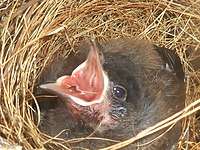Dark-capped bulbul
The dark-capped bulbul (Pycnonotus tricolor) is a member of the bulbul family of passerine birds. It is found in central, eastern and south-eastern Africa.
| Dark-capped bulbul | |
|---|---|
.jpg) | |
| P. t. tricolor, Kibale Forest, Uganda | |
 | |
| P. t. layardi, Mpumalanga, South Africa | |
| Scientific classification | |
| Kingdom: | Animalia |
| Phylum: | Chordata |
| Class: | Aves |
| Order: | Passeriformes |
| Family: | Pycnonotidae |
| Genus: | Pycnonotus |
| Species: | P. tricolor |
| Binomial name | |
| Pycnonotus tricolor (Hartlaub, 1862) | |
| Synonyms | |
| |
Taxonomy and systematics
The dark-capped bulbul was originally described in the genus Ixos. Some authorities treat the dark-capped bulbul as a subspecies of the common bulbul.[1] Alternate names include the black-eyed bulbul, brown-capped bulbul, garden bulbul, Kenya Highlands dark-capped bulbul, Ngami dark-capped bulbul, tricoloured bulbul and white-eared geelgat.[2]
Subspecies
Three subspecies are recognized:[3]
- P. t. spurius - Reichenow, 1905: Originally described as a separate species. Found in southern Ethiopia
- East Coast black-capped bulbul (P. t. layardi) - Gurney, 1879: Originally described as a separate species. Found from south-eastern Kenya to eastern and southern Zambia, north-eastern Botswana and South Africa
- P. t. tricolor - (Hartlaub, 1862): Found from eastern Cameroon to Democratic Republic of Congo, southern Sudan, western and central Kenya, Angola, north-western Botswana, and northern and western Zambia
Description

The dark-capped bulbul is mostly greyish brown above and whitish brown below, with a distinctive dark head and pointy crest on top of the head. The back of the head merges into the brown of the back, and the chin is also blackish. The underparts are grey-brown apart from white around the vent (yellow in P. t. tricolor). It is about 18 cm in length, with a long tail. It has a dark brown head and upperparts. Sexes are similar in plumage.
Vocalizations
References
- "Common Bulbul (Pycnonotus barbatus)". Fishpool, L. & Tobias, J. (2017). In: del Hoyo, J., Elliott, A., Sargatal, J., Christie, D.A. & de Juana, E. (eds.). Handbook of the Birds of the World Alive. Lynx Edicions, Barcelona. Retrieved 11 November 2017.
- "Pycnonotus tricolor - Avibase". avibase.bsc-eoc.org. Retrieved 2017-03-27.
- "Bulbuls « IOC World Bird List". www.worldbirdnames.org. Retrieved 2017-03-27.
External links


- Black-eyed Bulbul - Species text in The Atlas of Southern African Birds.